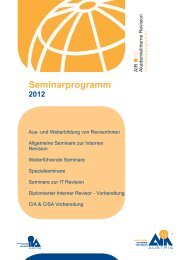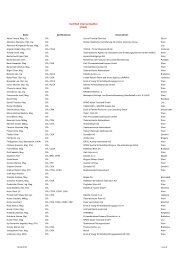2011 State of the Internal Audit Profession Study - PwC
2011 State of the Internal Audit Profession Study - PwC
2011 State of the Internal Audit Profession Study - PwC
Create successful ePaper yourself
Turn your PDF publications into a flip-book with our unique Google optimized e-Paper software.
“When you think about <strong>the</strong> differences between<br />
technology changes and accounting standards<br />
changes, you’re talking night and day. Think<br />
about cloud computing; it’s changing at<br />
<strong>the</strong> speed <strong>of</strong> light compared to changes to<br />
accounting standards. Think about how quickly<br />
a virus can infect your systems. These are things<br />
you have to deal with right now.”<br />
A leading CAE<br />
Social media, e-mobility,<br />
and cloud computing<br />
The emergence <strong>of</strong> social media,<br />
e-mobility, and cloud computing<br />
represents significant opportunities for<br />
companies to interact with employees<br />
and customers in ways never before<br />
considered. These opportunities also<br />
represent heightened risks associated<br />
with reputation and brand damage,<br />
data leakage, and security. However, if<br />
<strong>the</strong>se risks are well managed, opportunities<br />
for reduced costs and access to<br />
new revenue streams can be great.<br />
Social media and e-mobility<br />
Social media and networking technology<br />
refers to a range <strong>of</strong> s<strong>of</strong>tware<br />
programs that are <strong>of</strong>ten web-based<br />
and allow users to interact and share<br />
data with o<strong>the</strong>r users. These interactions<br />
occur through <strong>the</strong> forming <strong>of</strong><br />
communities and <strong>the</strong> empowerment<br />
<strong>of</strong> individuals within <strong>the</strong>se communities<br />
to engage with one ano<strong>the</strong>r. This<br />
computer-mediated communication has<br />
become popular with social sites such<br />
as Facebook, Twitter, and MySpace, as<br />
well as media sites such as Flickr and<br />
YouTube, and commercial sites such as<br />
Amazon.com and eBay.<br />
For businesses, social networking and<br />
e-mobility can be a transformational<br />
phenomenon, introducing new ways<br />
<strong>of</strong> engaging consumers and new ways<br />
to empower and engage employees<br />
and stakeholders. Business uses<br />
<strong>of</strong> social networking technologies<br />
include marketing, idea management,<br />
and recruitment.<br />
There is, no doubt, a significant potential<br />
for growth through <strong>the</strong> use <strong>of</strong> social<br />
networking to connect with customers<br />
and employees. This opportunity<br />
should not be underestimated. By<br />
connecting with customers and clients<br />
through this new channel, organizations<br />
are able to build brand loyalty<br />
and easily share ideas. However, with<br />
this opportunity comes increased risk:<br />
• Damage to brand: Social<br />
networking provides customers with<br />
an outlet to share comments about a<br />
company, its products and services.<br />
This can be valuable if constructive;<br />
however, if done maliciously,<br />
this can taint a company’s brand<br />
image. For example, employees<br />
staging a joke about food preparation<br />
at a national pizza chain posted<br />
a video on YouTube. Within days <strong>the</strong><br />
video had been viewed more than a<br />
million times, and it showed up in<br />
<strong>the</strong> top ten Google search returns.<br />
• Data loss: With employees having a<br />
direct connection to so many people,<br />
<strong>the</strong>re is an increased risk that proprietary<br />
information could be accidentally<br />
or intentionally leaked to <strong>the</strong><br />
public. These multiple connections<br />
can also lead to customer data loss<br />
due to hacking.<br />
• Distribution <strong>of</strong> malware: Due<br />
to increased connectivity with<br />
social networking, even a minor<br />
system hack can spread quickly. For<br />
example, services such as TinyURL,<br />
Bit.ly, and Cligs have become<br />
popular as <strong>the</strong>y allow URLs to be<br />
displayed in a more succinct form<br />
by Twitter users. There have been<br />
hacking incidents in which <strong>the</strong>se<br />
shortened URLs were changed<br />
to a single URL, presenting a risk<br />
that users could be redirected to<br />
malicious websites.<br />
11






![Ausgabe 02_2011 [PDF, 3.4 MB] - Institut für Interne Revision ...](https://img.yumpu.com/37945857/1/184x260/ausgabe-02-2011-pdf-34-mb-institut-fa-1-4-r-interne-revision-.jpg?quality=85)

![Ausgabe 2004.2 [PDF, 1.1 MB] - Institut für Interne Revision Ãsterreich](https://img.yumpu.com/37941871/1/184x260/ausgabe-20042-pdf-11-mb-institut-fa-1-4-r-interne-revision-asterreich.jpg?quality=85)
![Ausgabe 02_2009 [PDF, 1.2 MB] - Institut für Interne Revision ...](https://img.yumpu.com/37941824/1/184x260/ausgabe-02-2009-pdf-12-mb-institut-fa-1-4-r-interne-revision-.jpg?quality=85)

![Ausgabe 03_2011 [PDF, 9.1 MB] - Institut für Interne Revision ...](https://img.yumpu.com/37941423/1/184x260/ausgabe-03-2011-pdf-91-mb-institut-fa-1-4-r-interne-revision-.jpg?quality=85)
![Ausgabe 2006.2 [PDF, 852.7 KB] - Institut für Interne Revision ...](https://img.yumpu.com/37941416/1/184x260/ausgabe-20062-pdf-8527-kb-institut-fa-1-4-r-interne-revision-.jpg?quality=85)
![Ausgabe 03_2007 [PDF, 1.5 MB] - Institut für Interne Revision ...](https://img.yumpu.com/37941405/1/184x260/ausgabe-03-2007-pdf-15-mb-institut-fa-1-4-r-interne-revision-.jpg?quality=85)

![CEE Konferenzprogramm [PDF, 11.8 MB] - Institut für Interne ...](https://img.yumpu.com/37941387/1/184x260/cee-konferenzprogramm-pdf-118-mb-institut-fa-1-4-r-interne-.jpg?quality=85)
